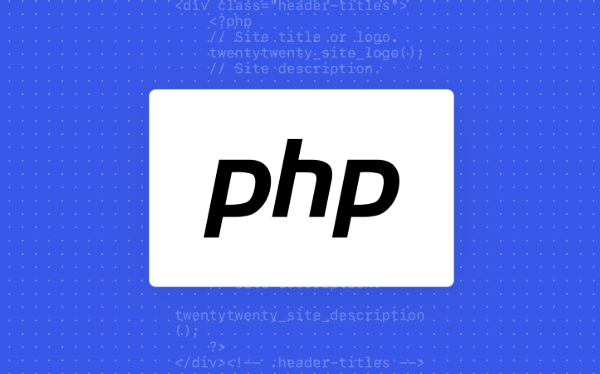 Backend Development
Backend Development
 PHP Tutorial
PHP Tutorial
 From Clutter to Clarity: Simplifying Validation Logic with `continue`
From Clutter to Clarity: Simplifying Validation Logic with `continue`
From Clutter to Clarity: Simplifying Validation Logic with `continue`
Aug 01, 2025 am 07:47 AMUse the continue statement to convert complex nested verification logic into clear linear structures; 1. Prioritize the verification of invalid situations in the loop and skip them with continue to avoid deep nesting; 2. Each condition is used as a pre-guard to ensure that the main logic is in the "safe area"; 3. Further improve readability by extracting condition variables or encapsulating helper functions; 4. It is suitable for multi-condition filtering scenarios, but excessive linearization or abuse in complex states should be avoided; this method reduces the cognitive burden through early exit, making the main process more intuitive, and ultimately achieves the simplicity and maintainability of the code.

Let's be honest—validation logic can get messy fast. When you're checking multiple conditions at the start of a function or loop, it's easy to end up with deeply nested if statements or a pyramid of doom that makes code hard to read and maintain. But there's a simple, often overlooked tool that can help: the continue statement.

Used wisely in loops, continue lets you skip the rest of the current iteration and jump to the next one. This makes it perfect for filtering out unwanted cases early—turning cluttered validation into clean, linear logic.
Here's how it works in practice.

Early Filtering with continue
Instead of wrapping your logic in layers of if-else blocks, use continue to handle invalid cases up front. This keeps the main logic flat and focused.
For example, imagine processing a list of user records:

for user in users:
if user.is_active:
if user.has_verified_email:
if user.last_login > threshold_date:
send_newsletter(user) This triple-nested structure is hard to follow. Now, flip the conditions and use continue to exit early:
for user in users:
if not user.is_active:
Continue continue
if not user.has_verified_email:
Continue continue
if user.last_login <= threshold_date:
Continue continue
send_newsletter(user) Now, each validation is a simple gate. If the user doesn't pass, skip to the next. The main action ( send_newsletter ) stands alone at the end, unburied.
Reduce Cognitive Load
The power of continue here is psychological as much as technical. By eliminating invalid cases early, you create a "safe zone" where you know all preconditions are met. This is sometimes called the guard clause pattern in loops.
Each continue acts like a bouncer: if you don't meet the criteria, you're out—no further processing. That means:
- You avoid deep indentation.
- You reduce branching complexity.
- You make the happy path obvious.
This clarity helps when debugging or adding new rules later.
When to Use It (and When Not To)
continue shines in loops over collections where you're filtering or validating input. But it's not always the best choice.
? Use continue when:
- You're iterating through data and want to skip invalid/irrelevant items.
- You have multiple independent checks.
- You want to keep the main logic at the same indentation level.
? Avoid or reconsider when:
- The logic becomes too linear with many
continuestatements (can extract to a function). - You're in a deeply nested context where
continuemight be confusing. - You're skipping based on complex state—might need refactoring.
Also, don't forget break for stopping entirely, or consider list comprehensions or filter() for simpler cases.
Bonus: Combine with Other Early-Exit Tools
You can mix continue with other clean-code practices:
- Extract conditions to named variables:
for user in users:
is_inactive = not user.is_active
unverified = not user.has_verified_email
old_login = user.last_login <= threshold_date
if is_inactive or unverified or old_login:
Continue continue
send_newsletter(user)- Or group related checks in a helper function:
def should_receive_newsletter(user):
Return (
user.is_active
and user.has_verified_email
and user.last_login > threshold_date
)
for user in users:
If not should_receive_newsletter(user):
Continue continue
send_newsletter(user)This keeps the loop even cleaner.
Basically, just flip your thinking: instead of "if all conditions pass, do X" , try "if any condition fails, skip to next" . With continue , you turn tangled validation into a series of simple, readable gates.
It's not magic—just a small shift that brings big clarity.
The above is the detailed content of From Clutter to Clarity: Simplifying Validation Logic with `continue`. For more information, please follow other related articles on the PHP Chinese website!

Hot AI Tools

Undress AI Tool
Undress images for free

Undresser.AI Undress
AI-powered app for creating realistic nude photos

AI Clothes Remover
Online AI tool for removing clothes from photos.

Clothoff.io
AI clothes remover

Video Face Swap
Swap faces in any video effortlessly with our completely free AI face swap tool!

Hot Article

Hot Tools

Notepad++7.3.1
Easy-to-use and free code editor

SublimeText3 Chinese version
Chinese version, very easy to use

Zend Studio 13.0.1
Powerful PHP integrated development environment

Dreamweaver CS6
Visual web development tools

SublimeText3 Mac version
God-level code editing software (SublimeText3)

Hot Topics
 How to combine two php arrays unique values?
Jul 02, 2025 pm 05:18 PM
How to combine two php arrays unique values?
Jul 02, 2025 pm 05:18 PM
To merge two PHP arrays and keep unique values, there are two main methods. 1. For index arrays or only deduplication, use array_merge and array_unique combinations: first merge array_merge($array1,$array2) and then use array_unique() to deduplicate them to finally get a new array containing all unique values; 2. For associative arrays and want to retain key-value pairs in the first array, use the operator: $result=$array1 $array2, which will ensure that the keys in the first array will not be overwritten by the second array. These two methods are applicable to different scenarios, depending on whether the key name is retained or only the focus is on
 php regex for password strength
Jul 03, 2025 am 10:33 AM
php regex for password strength
Jul 03, 2025 am 10:33 AM
To determine the strength of the password, it is necessary to combine regular and logical processing. The basic requirements include: 1. The length is no less than 8 digits; 2. At least containing lowercase letters, uppercase letters, and numbers; 3. Special character restrictions can be added; in terms of advanced aspects, continuous duplication of characters and incremental/decreasing sequences need to be avoided, which requires PHP function detection; at the same time, blacklists should be introduced to filter common weak passwords such as password and 123456; finally it is recommended to combine the zxcvbn library to improve the evaluation accuracy.
 How to handle File Uploads securely in PHP?
Jul 08, 2025 am 02:37 AM
How to handle File Uploads securely in PHP?
Jul 08, 2025 am 02:37 AM
To safely handle PHP file uploads, you need to verify the source and type, control the file name and path, set server restrictions, and process media files twice. 1. Verify the upload source to prevent CSRF through token and detect the real MIME type through finfo_file using whitelist control; 2. Rename the file to a random string and determine the extension to store it in a non-Web directory according to the detection type; 3. PHP configuration limits the upload size and temporary directory Nginx/Apache prohibits access to the upload directory; 4. The GD library resaves the pictures to clear potential malicious data.
 PHP Variable Scope Explained
Jul 17, 2025 am 04:16 AM
PHP Variable Scope Explained
Jul 17, 2025 am 04:16 AM
Common problems and solutions for PHP variable scope include: 1. The global variable cannot be accessed within the function, and it needs to be passed in using the global keyword or parameter; 2. The static variable is declared with static, and it is only initialized once and the value is maintained between multiple calls; 3. Hyperglobal variables such as $_GET and $_POST can be used directly in any scope, but you need to pay attention to safe filtering; 4. Anonymous functions need to introduce parent scope variables through the use keyword, and when modifying external variables, you need to pass a reference. Mastering these rules can help avoid errors and improve code stability.
 Commenting Out Code in PHP
Jul 18, 2025 am 04:57 AM
Commenting Out Code in PHP
Jul 18, 2025 am 04:57 AM
There are three common methods for PHP comment code: 1. Use // or # to block one line of code, and it is recommended to use //; 2. Use /.../ to wrap code blocks with multiple lines, which cannot be nested but can be crossed; 3. Combination skills comments such as using /if(){}/ to control logic blocks, or to improve efficiency with editor shortcut keys, you should pay attention to closing symbols and avoid nesting when using them.
 Tips for Writing PHP Comments
Jul 18, 2025 am 04:51 AM
Tips for Writing PHP Comments
Jul 18, 2025 am 04:51 AM
The key to writing PHP comments is to clarify the purpose and specifications. Comments should explain "why" rather than "what was done", avoiding redundancy or too simplicity. 1. Use a unified format, such as docblock (/*/) for class and method descriptions to improve readability and tool compatibility; 2. Emphasize the reasons behind the logic, such as why JS jumps need to be output manually; 3. Add an overview description before complex code, describe the process in steps, and help understand the overall idea; 4. Use TODO and FIXME rationally to mark to-do items and problems to facilitate subsequent tracking and collaboration. Good annotations can reduce communication costs and improve code maintenance efficiency.
 How Do Generators Work in PHP?
Jul 11, 2025 am 03:12 AM
How Do Generators Work in PHP?
Jul 11, 2025 am 03:12 AM
AgeneratorinPHPisamemory-efficientwaytoiterateoverlargedatasetsbyyieldingvaluesoneatatimeinsteadofreturningthemallatonce.1.Generatorsusetheyieldkeywordtoproducevaluesondemand,reducingmemoryusage.2.Theyareusefulforhandlingbigloops,readinglargefiles,or
 How to create an array in php?
Jul 02, 2025 pm 05:01 PM
How to create an array in php?
Jul 02, 2025 pm 05:01 PM
There are two ways to create an array in PHP: use the array() function or use brackets []. 1. Using the array() function is a traditional way, with good compatibility. Define index arrays such as $fruits=array("apple","banana","orange"), and associative arrays such as $user=array("name"=>"John","age"=>25); 2. Using [] is a simpler way to support since PHP5.4, such as $color





